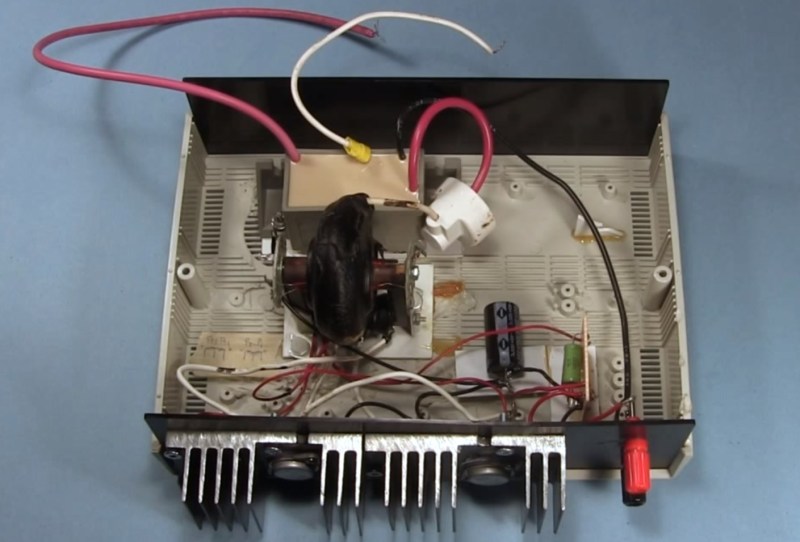If you have need for 30,000 volts to launch your ionocraft (lifter) or power other DIY projects then shuttle over to RimstarOrg’s YouTube channel and checkout [Steven Dufresne’s] homebuilt 30kV power supply. The construction details that [Steven] includes in his videos are always amazing, especially for visual learners. If you prefer text over video he was kind enough to share a schematic and full write up at rimstar.org.
The power supply can be configured for 1.2kV – 4.6kV or 4kV – 30kV at the output while requiring 0-24V DC at the input. In the video [Steven] tries two power supplies. His homemade DC bench power supply at 8V and 2.5A and also a laptop power supply rated at 20V 1.8A DC. A couple of common 2N3055 power transistors, proper wattage resistors, a flyback transformer and a high voltage tripler is about all you’ll need to scrounge up. The flyback transformer can be found in old CRT type televisions, and he does go into details on rewinding the primary for this build. The high voltage tripler [Steven] references might be a bit harder to source. He lists a few alternates for the tripler but even those are scarce: NTE 521, Siemens 76-1 N094, 1895-641-045. There are lots of voltage multiplier details in the wild, but keep in mind this tripler needs to operate up to 30kV.
Join us after the break to watch the video and for a little advice from Mr. Safety.
What good is a high voltage power supply if you don’t travel around in a homebuilt ionocraft just yet? Well maybe you need to electrify your Wolverine claws or Thor’s hammer. We couldn’t close this article without a shout out to the master of high voltage hacks [Photonicinduction] now known as [Photonvids] on YouTube.
Time for Mr. Safety:
Q – Mr. Safety, Is this dangerous?
A – Very! Do not try building something like this unless you really know what you are doing. You can easily be killed by the output and by other points in this circuit. Follow [Steven’s] safety tips when operating such a power supply. Remember to ground the outputs after shutting down. The high voltage tripler can store quite a jolt in its internal capacitors so be careful with that device in and of itself.

















Flybacks are so much fun to play with……..but ohhh sooooo dangerous…nice build tho.
At first glance, I thought he had a bat (mammal) sitting in the middle of the circuit.
I totally though at first it was powered by a rat turning a wheele that it was hunched over working intensely!! Lol. So I’m with you on the mammal thing!!!
Simple 2 transistor push-pull feedback supply … not the best way to do it … a mosfet and a tuned 555 is a great cheap way of doing it (0.01uf cap, 2 10k pots) … you can also use a ZVS supply but those can cause issues with over powering the flyback making them not last long at all …
Hands up who wants to use a 12V wall wart that pushes out 18.31V?
As BiOzZ says, there are better flyback drivers, particularly the Mazzilli ZVS driver. The 4hv wiki has some good driver circuits, including the ZVS: http://wiki.4hv.org/index.php/Flyback_transformer
Steve Connor has another high powered IGBT based driver here:
http://scopeboy.com/tesla/flyback.html
I don’t think that Steven Dufresne’s flyback driver is that dangerous as the power is low. However, high powered versions such as the ZVS and Steve Connor’s driver are dangerous. The ZVS can easily put 300W or more through a flyback at high efficiency, yielding flaming arcs. Modern flybacks are half-wave rectified and yield 15+mA, getting into heart fibrillation territory. The 20kV means that care is needed – this will punch straight through skin, clothing and ordinary cable insulation.
I’ve got to agree that my flyback driver is dangerous. That arc I show in my video at 9:52 when I bypass the resistors is plenty thick and long and doesn’t take long to build up.
I’ll have to try some of those better flyback drivers in the future. I haven’t done anything with MOSFETs yet so it’d be a good opportunity. However, this 30kV power supply has done an awful lot for me over the years and survived wonderfully. It’s like a favorite homemade tool I’m glad I made in the first place.
I’ve got a HV transformer sitting around if someone wants it: I think it’s somewhere around 5-50kV out, 220V ~50-60A in. You pay shipping: will require freight.
Bank of 20, 450 Volt Nippon Capacitors.
Total Volt: 9,000
Total µF: 48,000
Weight: Approx 50#
http://cgi.ebay.com/ws/eBayISAPI.dll?ViewItem&item=321463321132
How much over all cost. I need 30kv DC supplier. Is all components are available in market.
I am working on nano spinning machine, i want 30KV DC for my machine, can you please help me that how can i make a circuit of 220 volts to 30KV DC,and output current is 0.6mAmpare.
sir can you send my ckt diagram of this project
It’s at the 2nd link given above, this one http://rimstar.org/equip/30kv_pwr_supply.htm.